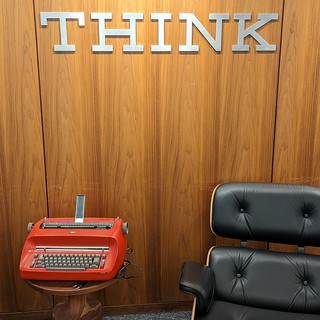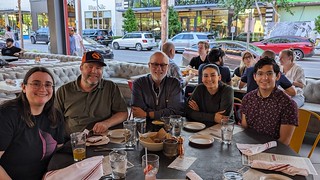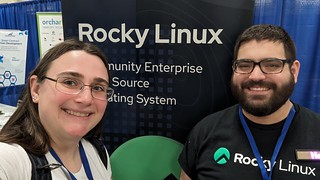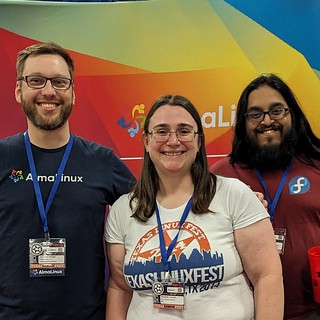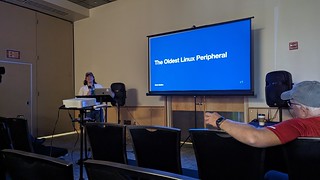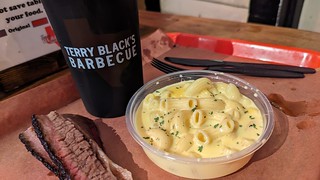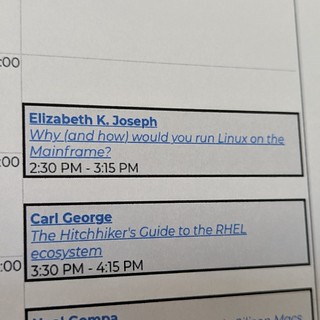The last Texas Linux Fest I attended was all the way back in 2014, which means it had been a full 10 years since I’d been. I was supposed to speak at the event in 2020, but no one spoke in 2020, so I was really happy to finally, finally be back.
But first, I made a stop at the IBM office in Austin where I met up with my colleagues Daniel and Chris. I met Daniel at a taco truck where I had a much-needed post-flight lunch, and then he gave me a tour of the office. I even managed to find a random, roaming IBM Selectric II typewriter!
Then I got to enjoy happy hour out with several other folks from the office before returning back to my hotel for the night.
The first day of the conference I mostly spent meeting people and in the expo hall chatting with folks from Rocky Linux and AlmaLinux. They both have builds for s390x, so it was really nice to finally meet the folks I’ve worked with online, and talk with them in person about their current utilization and changes in needs. And that evening I was able to grab dinner and ice cream with my contact at Rocky Linux.
The second day was the one that was filled with talks. The event kicked off with a keynote from Anita Zhang about her career, and how unexpected choices at various stages led to the success she’s found today. From there I went directly to a talk by Matt Mullins of the Connections Museum Seattle titled “The oldest Linux peripheral” where he talked about a panel switch from 1923 that’s now hooked up to a Linux box to manage operations. It was a really cool talk, and looks to be a fascinating museum with a lot of old telecommunications equipment. The hours they’re open don’t line up with my upcoming visit to Seattle, but maybe next time, I know it’s something MJ would love to see.
From there I went to a talk from Paul Novarese on “The Legacy of Log4Shell and the Future of DevSecOps” where he gave a bit of a tour of the open source security landscape, and shared statistics around the exponentially growing number of open source projects and versions available, along with the corresponding rise in CVE assignments and NIST Vulnerability Database analysis work. Some of his observations centered around the fact that these procedures were developed at a time when the open source ecosystem was a lot smaller, and the dependency chain was somewhat less abstracted (or at least, less complicated). He talked about SBOMs (Software Bill of Materials) that can help organizations get a handle on the supply chain, but analysis and fixes also have to keep up so you have data to search for in that SBOM as you look for vulnerable software.
I took lunch a little early so I could prepare for my talk, and ended up at Terry Black’s BBQ across the street from the venue.
My talk on “Why (and how) would you run Linux on the Mainframe?” went well! It was well-attended and I think about half the attendees had a passing familiarity with mainframes, but a lot of the audience was new to the topic, which is about what I’d expect at a Linux event these days. People had great questions and it was really fun to geek out about it for the rest of the event, even at the after party for the conference the questions and discussions continued over drinks.
From there I went to Kyle J. Davis’ talk “Container Optimized Linux: The best idea you’re probably not using.” He had worked with Bottlerocket, but Flatcar and Talos are also in the host container OS space, and while I vaguely knew they existed, this was the first time I sat down and dedicated a few minutes to hear someone talk about them. The slim model they have for these distributions makes a lot of sense, since you really do only need a tiny, secure, environment to actually run the containers on, and everything can be externally orchestrated. While not directly applicable to me right now (IBM has done a lot of work on our own secure container environments), it is something I’ll keep in mind if the opportunity arises.
The final talk I attended before lightning talks and closing was around the Fedora work with Asahi Linux to bring it to the ARM-based Apple macs. I don’t have a great interest in this hardware specifically, but I always enjoy hearing about other architecture porting work that’s happening, and it was interesting to see the challenges that they’re presented with, along with progress and solutions.
For dinner before the after party I ended up eating with folks I knew from the OpenStack, and broadly, the Fedora community, before we all walked over to the Gibson Street Bar. I was feeling a little tired at this point, but I ended up staying clear through until 10PM. I then took a short detour over to a mailbox to send off a post card for the boys before retiring to my hotel.
Today is Sunday and I’m off on my next adventure: Seattle for the Open Source Summit!


